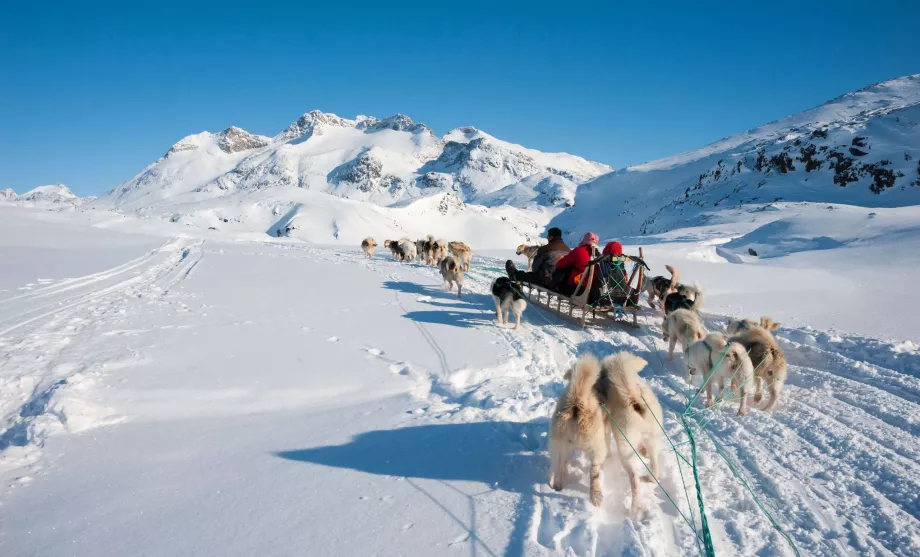Northern Lights in Greenland

Seeing the celestial play of colours known as the aurora borealis is a lifelong dream for many travellers.
One of the best places to see the aurora borealis is Greenland. It lies far enough north, but also has plenty of spots south of the Arctic Circle. In fact, if you are too far outside the Arctic Circle, the aurora borealis fades again.
Greenland is also the least populated country in the world with the least light pollution.
In short, Greenland is in an ideal location and, despite the harsh winter weather, attracts many tourists from all over Europe and America at this time of year.
In this article we will not describe how and why the Northern Lights are created, but when and under what conditions to see them in Greenland.
When to go - the best months
The success of aurora viewing depends on many factors, most of which are beyond our control. The only one we can influence is choosing the right time to travel to Greenland for the aurora.
An important prerequisite for observing is, of course, darkness.
The Aurora Borealis is a year-round and all-day phenomenon, but the human eye can only see it during the night. Since there is no dark night in Greenland during the summer, you have to go in winter.
The first month when there is little chance of sighting is late August, while the last month is late April. However, there is still more light than darkness in these months, so the chances will still be relatively slim.
The best time is late September to late March.
While the darkness is at its greatest in late November and December, these months are also often cloudy for long days, plus the darkness and harsh conditions (frost, wind, snow) will make your schedule for the rest of the day quite tight.
By the end of February or October, on the other hand, it's dark enough in the evenings and at night, and you'll also have a decent chance of clear skies, plus you'll enjoy plenty of light and decent weather during the day to explore Iceland.
| January | High season |
|---|---|
| February | High season |
| March | High season |
| April | Medium Chance |
| May | Low to no chance |
| June | No chance |
| July | No chance |
| August | No to low chance at the end of the month |
| September | Low to medium chance |
| October | High chance at the end of the month |
| November | High season |
| December | High season |
Search for flights to Greenland
Colours of the Aurora Borealis
The Aurora Borealis is an amazing and unique phenomenon every time. Sometimes a strong green colour spills across the sky standing still for long minutes, other times shades of deep red, purple or just a subtle greenish colour dance wildly in the sky.
The Northern Lights are simply differently coloured, differently saturated and differently moving each time. But the fact is that Greenland is the place in Europe with the richest auroras, along with Iceland and Norway.
Factors affecting the aurora borealis
In addition to the darkness, other important factors affect aurora observations:
- Solar activity - sufficient solar activity is necessary for a strong enough aurora. This is described by the so-called Kp-index, which indicates the disturbance of the Earth's magnetic field by the solar wind, which causes the aurora. The Kp-index is given on a scale from 0 (no activity) to 9 (intense solar storm). While a level of activity of 3 is sufficient to see auroras in Greenland, for example, to see them in continental Europe they need to be at a level of 7 to 8.
- Actual weather - the basic assumption is clear skies and no clouds in the lower and middle layers (high clouds do not matter)
- Light pollution - Greenland, with its only major city, is ideally suited for this. Moreover, if there is strong solar activity (Kp-index above 5) and it is clear, you can see the glow from Reykjavik.
Aurora forecast sites
A site directly dedicated to predicting the aurora borealis will be a great help in your aurora hunting. Probably the most straightforward Greenland aurora sighting site is aurorareach.com.
Where exactly to go in Greenland?
Many travelers ask where is the exact specific and the "one true" place to view the aurora borealis. It's simple: there is no specific place.
Greenland has a huge disadvantage compared to, say, Iceland or Norway, in that if you are in one place, you simply cannot move to another place with a more favourable forecast.
Moves in Greenland are only possible by air or ferry and usually cost hundreds of euros and need to be planned well in advance.
In this respect, it is therefore safest to plan a long enough stay in one place in Greenland to increase your chances of at least one day of good skies.
The best places for aurora viewing are around the Arctic Circle, and ideally in towns where other activities are possible:
The Aurora Borealis is often visible from the largest city, Nuuk, but there is already some light pollution and Nuuk suffers from frequent fog and cloudy weather.
Are there better countries for aurora viewing?
That's a rather complicated question.
Greenland is a destination for a specific type of traveller who seeks out not-so-explored lands and doesn't mind spending extended periods of time in isolation from civilization. From this perspective, Greenland is a great country for catching the Northern Lights.
If you're more in the mainstream category of traveller, then Iceland or Norway are definitely better suited, where you can do significantly more activities than in Greenland, in addition to the Northern Lights.
Plus, you can get to Iceland and Norway significantly cheaper than Greenland.
Any questions left?
If you have any questions or comments about the article...

